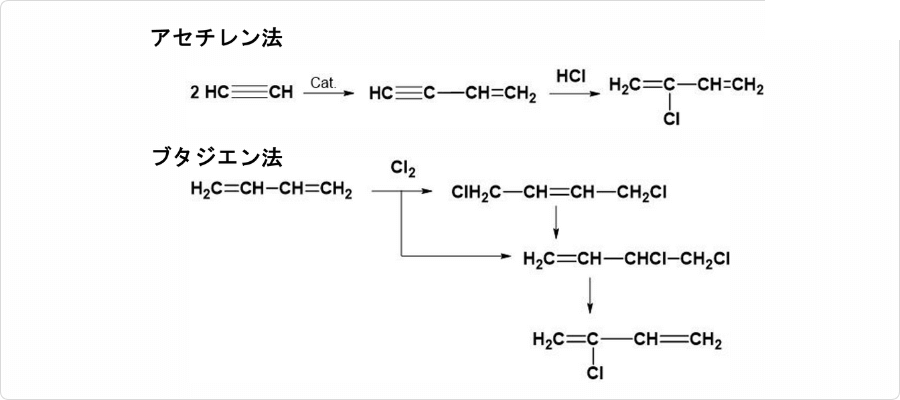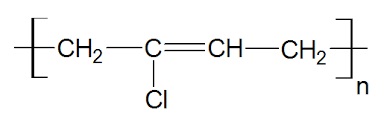ポリクロロプレン 化学特性,用途語,生産方法
解説
クロロプレンCH2=CCl-CH=CH2の高重合体.ペルオキソ-硫酸カリウムを触媒として乳化重合によって得られる.普通,80% 以上がトランス-1,4構造を有する.trans-1,4-ポリクロロプレンは密度1.65 g cm-3(25 ℃,結晶),1.23 g cm-3(25 ℃,非晶).結晶の融点 Tm = 80 ℃,ガラス転移温度 Tg - 47 ℃,θ溶媒はメチルエチルケトンである.合成ゴムとして利用されている.森北出版「化学辞典(第2版)
構造

図1. クロロプレンゴムの構造
クロロプレンゴムは主鎖に二重結合を有すること、二重結合を有する炭素に直接塩素が結合している構造であることが特徴の一つです。主鎖に塩素が含まれているため、他の汎用ゴムよりも耐油、耐薬品、耐熱性に優れています。
クロロプレンゴムの原料としてはもしくはが用いられます。アセチレンを二量化した後にを付加する、またはブタジエンを塩素と反応させた後にによって脱塩酸反応を起こすことでクロロプレンモノマーを得ることができます。ちなみにこれら2つの方法のうちアセチレン法は副反応によって爆発性の高い化合物も生成するため、一般的にはブタジエン法が採用されています。
このクロロプレンモノマーを重合させることでクロロプレンゴムを製造します。なお一般的に重合法としてラジカル乳化重合が採用されています。
用途
クロロプレンCH2=CClCH=CH2の重合体(ポリマー)で、代表的な合成ゴムの一つ。1931年アメリカのデュポン社からデュプレンDupreneという商品名で市販され、ついでネオプレンNeopreneと改称された。ポリクロロプレンは,単独、あるいは共重合体とし、合成ゴムとして用いられる。耐候性、耐油性にすぐれ、天然ゴムよりも燃えにくい。油用ホース、ベルトなどに用いられる。商標名はネオプレン。
主な用途/役割
クロロプレンの重合で得られる合成ゴム。布、プラスチックフィルム、紙、発泡体のようなフレキシブルなものを接着する接着剤、木材用水系高分子イソシアネート系接着剤に使用される。
説明
Neoprene, also known as polychloroprene and chloroprene rubber, is an elastomer produced by polymerization of chloroprene.
化学的特性
The appearance of neoprene is milky white, beige or light brown flakes or lumps. Its density is 1.23–1.25 g.cm
–3. The
solubility parameter δ of neoprene is 9.2–9.41. Neoprene is soluble in toluene, xylene,
chloroform, and dichloroethane, and slightly soluble in acetone, methyl ethyl ketone,
ethyl acetate, cyclohexane but insoluble in n-hexane and solvent gasoline. Neoprene has good physical, chemical and mechanical properties. In comparison with natural rubber, it is much denser, more resistant to water and hydrocarbon
solvents, less permeable to many gases, and was more resistant to degradation by
oxygen, ozone, hydrogen chloride, hydrogen fluoride, and other chemicals. It has
certain flame retardance. The decomposition temperature is 230–260°C, and it can
be used for a long time at 80–100°C.
来歴
Polychloroprene was discovered in 1930 at E. I. DuPont de Nemours & Co. inWilmington Delaware. The discovery grew out of a need to develop a synthetic substitute for natural rubber. DuPont first marketed this first commercially successful synthetic elastomer as DuPrene in 1933. In response to new technology development that significantly improved the product and manufacturing process, the name was changed to Neoprene in 1936. The current commercially acceptable generic name for this class of chlorinated elastomers is CR or chloroprene rubber.

polychloroprene structure
使用
Polychloroprene is a (Solid) Mechanical rubber products, lining oil-loading hose and reaction equipment, adhesive cement, binder for rocket fuels, coatings for electric wiring, gaskets and seals. (Liquid) Specialty items made by dipping or electrophoresis from the latex. (Foam) Adhesive tape to replace metal fasteners for automotive accessories, seat cushions, carpet backing, sealant
定義
ChEBI: A macromolecule composed of repeating (2Z)-2-chlorobut-2-ene-1,4-diyl units.
調製方法
Commercial polychloroprene rubber is manufactured by aqueous free-radical emulsion polymerization followed by isolation of the solid polymer by one of several processes: freeze roll isolation, drum drying , extruder isolation, precipitation and drying or spray drying. Isolation of powdered polychloroprene has been reviewed. Of the methods cited, freeze roll and drum drying isolation are commercially important.
The large-scale commercial manufacture of polychloroprene consists of eight or nine unit operations:
(1) Monomer solution makeup Water solution makeup
(2) Emulsification
(3) Polymerization
(4) Stripping of residual monomer
(5) Peptization for chloroprene–sulfur copolymers
(6) Freeze roll isolation Drum drying
(7) Drying of freeze-rolled film
(8) Roping
(9) Cutting and packaging (25kg)
製造方法
Polychloroprene is made from one of two starting materials, acetylene or butadiene. Acetylene can be dimerized and then chloronated to form chloroprene. Alternatively, when adequate butadiene is available, this can be directly halogenated (eqs. 7 and 8). In either case, the chloroprene product can then be polymerized to polychloroprene. Essentially a butadiene elastomer with chlorine present in the backbone,the polymer exhibits excellent tensile strength and low hysteresis, much like natural rubber. Tensile strength properties up to 28 MPa are possible with the proper reinforcing system (see FILLERS). The polarity imparted by the chlorine atom improves the oil and solvent resistance approaching those of nitrile polymers. The polymer can be protected with para-phenylenediamine antiozonants to give ozone resistance, and heat aging is also good. As a result, chloroprene elastomers are used in a wide variety of applications needing a balance of such properties.
危険性
Questionable carcinogen.
使用用途
クロロプレンゴムは合成ゴムの一種で耐オゾン性、耐油性、耐熱性などに優れたゴムです。物性も含めた様々な観点でバランスの取れたゴムとも言え、数多くの業界で用いられています。
クロロプレンゴムの用途としては例えば自動車のベルトやホース、ワイヤーやケーブル、Oリングなどが挙げられます。また有機溶剤に溶解させて接着剤として用いることもあります。クロロプレンゴムを用いた接着剤はゴムや金属、硬質プラスチックなど幅広い材料に用いることが可能です。
物性
クロロプレンゴムには主鎖中の一部の化学構造を変性させることで物性を変化させたものも販売されています。一般的に用いられるのはメルカプタン変性タイプで様々な物性がバランスよく優れたゴムです。その他、分子鎖の末端で反応が起きやすいキサントゲン変性タイプでは分子鎖同士が反応することで高分子量化、網目構造化した機械的物性、防振特性に優れたゴムが得られます。また主鎖の中に比較的弱い結合である硫黄結合を含み、混練時に切断、低粘度化させることができる硫黄変性タイプというクロロプレンゴムも販売されています。
なおクロロプレンゴムは製造プロセス、反応性の観点から他のモノマーとの共重合品を得るのは容易ではありません。そのため、他の合成ゴムと比較すると新たな特性を有するクロロプレンゴム共重合品の種類、数は限られています。しかし、その中でも例えばと共重合させたゴム、2,3-ジクロロ-1,3-ブタジエンと共重合させたゴムが存在し、前者は加硫特性や接着性などに、後者は低温特性に特徴を有するものとして用いられています。
工業用途
One of the first synthetic rubbers used commercially to the rubber industry, neoprene is a polymer of chloroprene, 2-chlorobutadiene- 1,3. In the manufacturing process, acetylene, the basic raw material, is dimerized to vinylacetylene and then hydrochlorinated to the chloroprene monomer.
Sulfur is used to vulcanize some types of neoprene, but most of the neoprenes are vulcanized by the addition of basic oxides such as magnesium oxide and zinc oxide. The cure proceeds through reaction of the metal oxide with the tertiary allylic chlorine that arises from the small amount of 1,2-polymerization that occurs. Other compounding and processing techniques follow similar procedures and use the same equipment as for natural rubber. One of the outstanding characteristics of neoprene is the good tensile strength without the addition of carbon black filler. This versatility makes them useful in many applications requiring oil, weather, abrasion, or electrical resistance or combinations of these properties, such as wire and cable, hose, belts, molded and extruded goods, soles and heels, and adhesives.
材料の用途
The most widely used contact adhesive is a solution of polychloroprene or modified polychloroprene in solvent blends of aromatic hydrocarbons, aliphatic hydrocarbons, esters, or ketones, for example, toluene–hexane–acetone. Viscosity, dry time needed before bonding, bond strength, and price are affected by the solvent. Using various combinations of the isomeric forms of polymerized 2- chlorobutadiene permits a fine-tuning of the crystallization rate of the dissolved polymer as the solvent evaporates. The polychloroprene may also be modified by the incorporation of methacrylic acid or mercaptans. Metal oxides (MgO and ZnO) that scavenge acids are often part of polychloroprene adhesives and also may act as cross-linking agents. Oxygen scavengers such as butylated hydroxytoluene (BHT) [128-37-0] or naphthylamines [25168-10-9] are added to prevent dehydrochlorination. To build initial handling strength, the solvent-based polychloroprene contact adhesives may be modified with alkyl phenolics, terpene phenolics, or phenolic-modified rosin esters, the first of these being the most effective and least deleterious. Chlorinated rubbers are sometimes added to these adhesives to improve their adhesion to plasticized PVC and other plastics. Added just before adhesive application, isocyanates are useful in modification of polychloroprene contact adhesives, reacting perhaps through hydrolysis of the pendant allylic groups present from the small number of 1,2 isomeric segments. The remainder of the solvent-based contact adhesives are comprised of polyurethane, SBR, styrene–butadiene–styrene block polymers, butadiene–acrylonitrile rubber, natural rubber, or various acrylic or vinyl resins in suitable solvents.
Advantages
By proper raw material selection and formulation of these polymers, the compounder can achieve optimum performance for a given end-use. Initially developed for resistance to oils and solvents it may resist various organic chemicals including mineral oils, gasoline, and some aromatic or halogenated solvents. It also exhibits good chemical resistance to aging and attack by ozone, and good resistance to UV irradiation (e.g., exposure to sunlight), until moderately elevated temperatures. Moreover, it has outstanding resistance to damage caused by flexing and twisting, an elevated toughness, and it resists burning but its electrical properties are inferior to that of natural rubber. Therefore, neoprene (polychloroprene) is noted for a unique combination of properties which has led to its use in thousands of applications throughout industry.
ポリクロロプレン 上流と下流の製品情報
原材料
準備製品